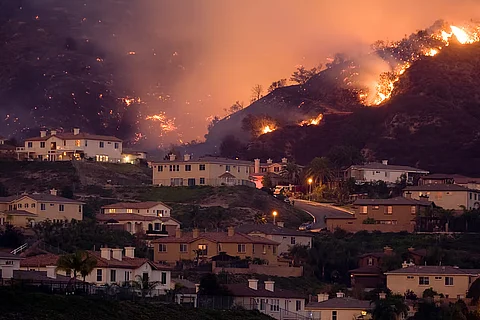

Human-induced climate change has been identified as the usual suspect that fuelled the hot, dry and windy conditions that made Los Angeles fires about 35 per cent more likely, according to a recently released report.
Global average temperatures, for the first time, crossed 1.5 degrees Celsius in 2024. If temperatures increase to 2.6C as expected by 2100, the likeliness of such fire-prone conditions will further by 35 per cent, warns the World Weather Attribution report, carried out by 32 researchers, including leading wildfire scientists from the United States and Europe.
Starting January 7, two fires broke out in the Palisades and Eaton counties in Los Angeles, California. Over the next few weeks, new fires were reported in San Diego County, according to data from California department of forestry and fire protection. Overall, more than 57,000 acres were burned, fuelled by exceptionally wildfire-prone conditions. There have been 28 reported deaths.
“Climate change increased the risk of the devastating LA wildfires,” Clair Barnes, World Weather Attribution Researcher at the Centre for Environmental Policy, Imperial College London, said in a statement.
Drought conditions, the expert added, are more frequently pushing into winter, increasing the chance a fire will break out during strong Santa Ana winds that can turn small ignitions into deadly infernos.
Fires in Southern California can occur nearly year-round. In summer (July through September), the region experiences large fires fuelled by extremely low fuel moistures. This is because summer precipitation is rare and evaporative demand is high. This combined with high temperatures, low humidity, and intense solar radiation, makes conditions ripe for fires.
The fires in January 2025 were made severe due to the arrival of strong Santa Ana winds before the region experienced enough rain to wet the vegetation and suppress fire risk.
The powerful Santa Ana mountain winds flow when air from a region of high pressure over the dry, desert region flows westward towards low pressure located off the California coast, creating dry winds that flow east to west. These winds are most common during the cooler months of the year. As the wildfires burned through tinder-dry vegetation, the fires rapidly spread into urban areas.
After analysing historical data, the researchers concluded that highly flammable drought conditions now last 23 more days each year on average than the preindustrial era.
Further, Southern California experiences rainfall in October-December rainfall, which has historically ended the wildfire season. But in recent decades, these rains have decreased, the researchers explained. Now, low rainfall across the three months is about 2.4 times more likely in neutral El Niño conditions, and a further 1.8 times more likely in La Niña conditions compared to the preindustrial climate. El Niño (warm phase) and La Niña (cool phase) are opposite phases of a natural climate pattern across the tropical Pacific Ocean that swings back and forth every 3-7 years on average. Neutral indicates that conditions are near their long-term average.
The researchers next conducted an analysis to see whether climate change helped promote the low October-December rainfall, lengthened fire season, and fire-prone weather. So the researchers combined weather data with climate models.
The models, however, did not perform well, partly due to the small, mountainous study area and the scattered, sparse rainfall. The models did find that climate change did influence the hot, dry, and windy conditions but did not show a significant impact on rainfall or the fire season’s end date.
The low rainfall recorded from October-December 2024 is also expected to occur around once every 20 years in the current climate. But this event would have been unusual in a 1.3°C cooler preindustrial climate.
“This was a perfect storm of climate enabled and weather driven fires impacting the built environment,” John Abatzoglou, Professor of Climatology at the University of California Merced, said in a statement.
Roop Singh, Head of Urban and Attribution at the Red Cross Red Crescent Climate Centre, explained that the onslaught was due to a deadly combination of factors.
“Climate change set the stage, helping turn the hills around LA tinder-dry. However, hurricane-force Santa Ana winds, the rapid spread of fires into urban zones, and a strained water system all made the blazes extremely difficult to contain,” Singh added.
These fires, he highlighted, show how vulnerable California is to winter wildfires, underscoring the need for better preparation for a more dangerous future.